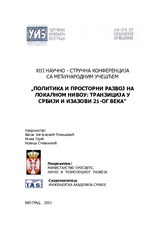Приказ основних података о документу
Комплексне типологије савременог становања - Модел за хибридне стамбене склопове
Complex typologies in contemporary housing - A Model for Hybrid Housing Configuration
| dc.creator | Стаменовић, Павле | |
| dc.creator | Стојановић, Душан | |
| dc.date.accessioned | 2023-10-10T08:51:13Z | |
| dc.date.available | 2023-10-10T08:51:13Z | |
| dc.date.issued | 2021 | |
| dc.identifier.isbn | 978-86-915671-9-4 | |
| dc.identifier.uri | https://raf.arh.bg.ac.rs/handle/123456789/1321 | |
| dc.description.abstract | Истраживање које је спроведено у овом раду има за циљ да истражи потенцијале сложених стамбених склопова за пројектовање и развој савремених насеља. Истраживање је спроведено у сврху учешћа на Отвореном међународном конкурсу за дизајн стандардизованог становања и станоградње (Open International Competition for Standard Housing and Residential Development Concept Design) у Русији, који је организовао Институт Стрелка у децембру 2017. године. У раду се развија упоредна теоријска анализа типова станова у Русији и Југославији друге половине XX века, (стамбени објекти Хрушчовке и новобеоградска становања) са циљем изградње платформе и полазишта за савремене моделе становања. Ово истраживање види потенцијал у одабиру и комбиновању специфичних аспеката модернистичке доктрине становања за савремене моделе становања, кроз компоновање сложених, хибридних конфигурација. У раду је такође развијена теоријска позиција хибридности као посттиполошког стања у архитектонском дискурсу. У овом случају, хибридност се разматра и у контексту програма, и у контексту форме. Савремени живот подразумева нове методе и моделе становања који превазилазе конвенционалне типолошке праксе, стога ово истраживање предлаже сложене конфигурације како би се одговорило на савремене потребе свакодневног живота. Приказано истраживање преиспитује статус префабрикованих, предефинисаних структура стамбених насеља (Хрушчовке), отварајући теме о трајању, одрживости и наслеђеним типовима становања у контексту прилагодљивих капацитета за савремене потребе становања.Горе објашњено упоредно истраживање даље се развија као истраживачко питање кроз конкурсно решење. Пројекат је развијен кроз просторни принцип који се, у зависности од просторних околности, може комбиновати и организовати у различитим конфигурацијама. | sr |
| dc.description.abstract | The research that is conducted in this paper aims to investigate the potentials of complex housing configurations for designing and developing contemporary, dynamic neighborhoods. Research is conducted for the purpose of participating in an Open International Competition for Standard Housing and Residential Development Concept Design in Russia, organized by the Strelka Institute in December of 2017. The paper develops a comparative theoretical analysis of housing types in Russia and Yugoslavia of the second half of XX century, (Khrushchyovka residential developments and New Belgrade housing) with the aim of constructing a platform, and a departure point for contemporary housing Models. This research sees the potential in selecting and combining specific aspects of modernist housing doctrine for contemporary housing models, through composing complex, hybrid configurations. Theoretical position for hybridity as a post-typological condition in architectural discourse is also developed in the paper. In this case, hybridity is considered both in the context of the program, as in the context of the form (vertical and horizontal). This paper argues that contemporary living implies new methods and models of housing that transgress conventional typological practices and involves complex configurations in order to address the contemporary needs of everyday life. Presented research questions the status of prefabricated, over-defined structures of Khrushchyovka residential developments, opening the topics of duration, sustainability and inherited types of living in the context of adaptive capacity for contemporary dwelling needs. The above-explained comparative research is further developed as a research by design through the competition proposal. The design proposal is developed as a spatial principle that, depending on the spatial circumstances, can be combined and organized in different configurations. Therefore, three suggested types are developed as variations of the principle. | sr |
| dc.language.iso | en | sr |
| dc.publisher | Београд : Удружење инжењера Београда | sr |
| dc.rights | openAccess | sr |
| dc.rights.uri | https://creativecommons.org/licenses/by/4.0/ | |
| dc.source | XIII Научно-стручна конференција са међународним учешћем "Политика и просторни развој на локалном нивоу: транзиција у Србији и изазови 21-ог века" | sr |
| dc.subject | Хибридност | sr |
| dc.subject | Становање | sr |
| dc.subject | Посттипологија | sr |
| dc.subject | Сложене структуре становања | sr |
| dc.subject | Hybridity | sr |
| dc.subject | Housing | sr |
| dc.subject | Post-typology | sr |
| dc.subject | Complex housing configurations | sr |
| dc.title | Комплексне типологије савременог становања - Модел за хибридне стамбене склопове | sr |
| dc.title | Complex typologies in contemporary housing - A Model for Hybrid Housing Configuration | sr |
| dc.type | conferenceObject | sr |
| dc.rights.license | BY | sr |
| dcterms.abstract | Stamenović, Pavle; Stojanović, Dušan; Kompleksne tipologije savremenog stanovanja - Model za hibridne stambene sklopove; | |
| dc.citation.spage | 96 | |
| dc.citation.epage | 112 | |
| dc.identifier.fulltext | http://raf.arh.bg.ac.rs/bitstream/id/4581/bitstream_4581.pdf | |
| dc.identifier.rcub | https://hdl.handle.net/21.15107/rcub_raf_1321 | |
| dc.type.version | publishedVersion | sr |

